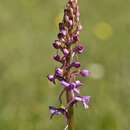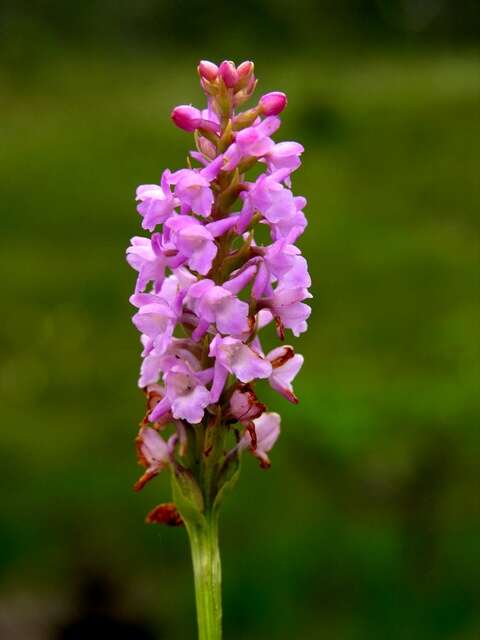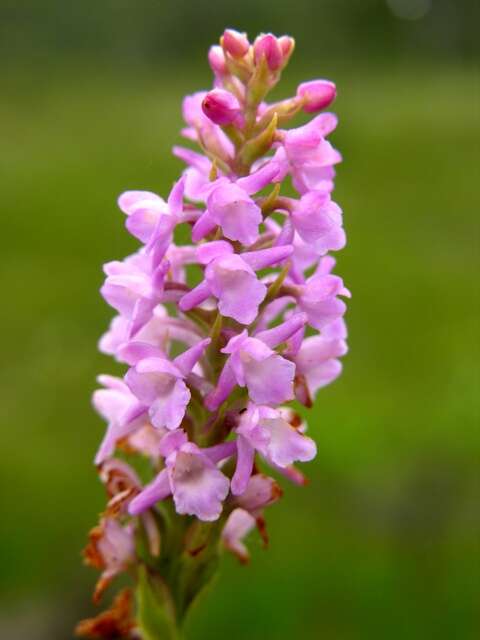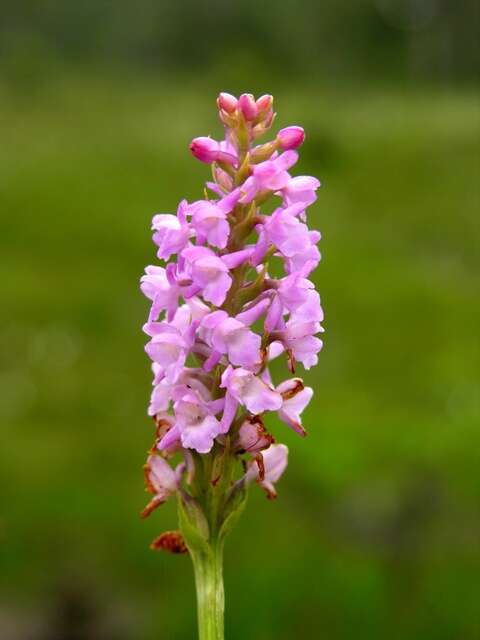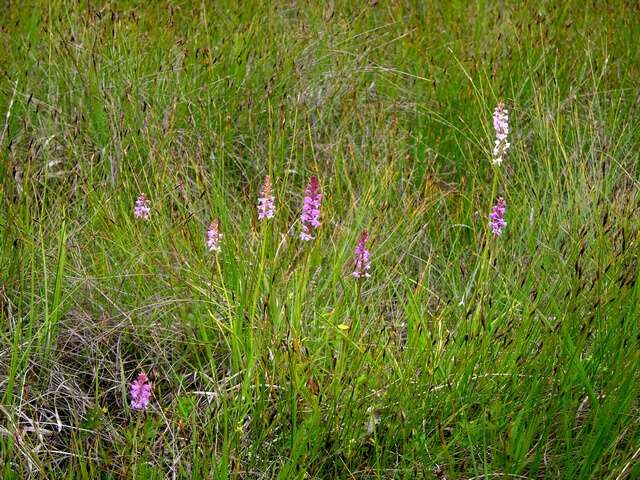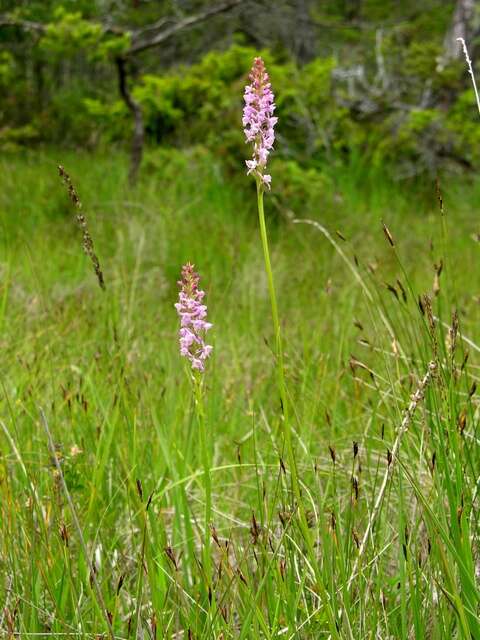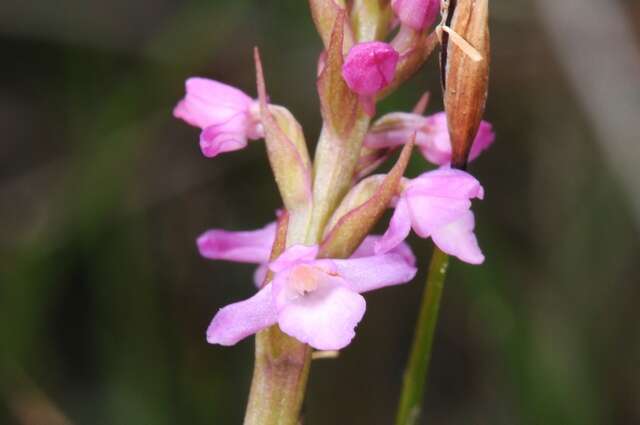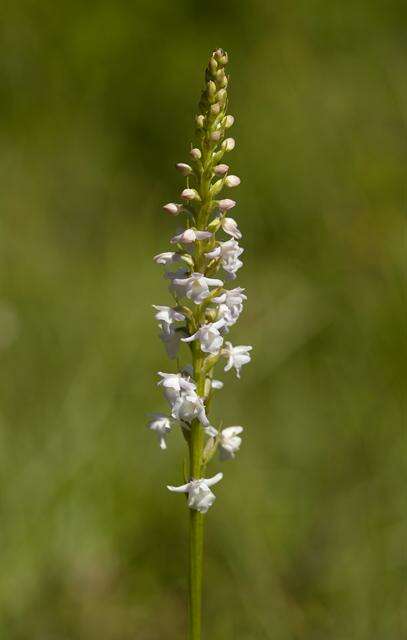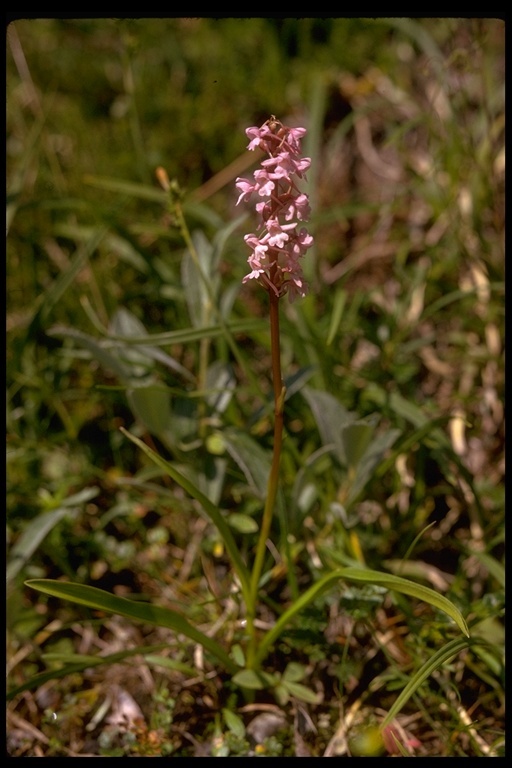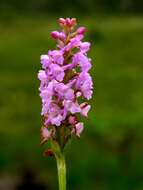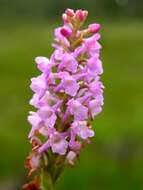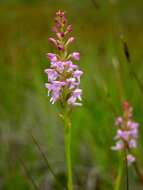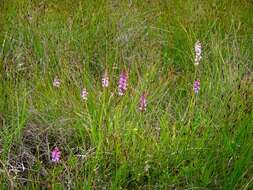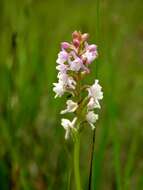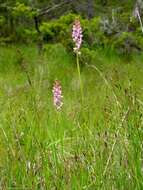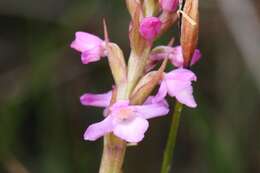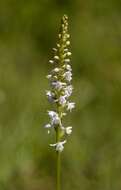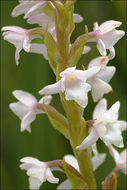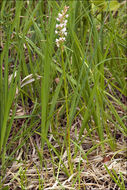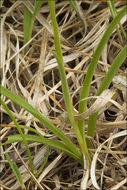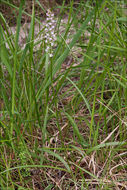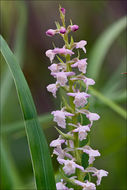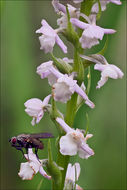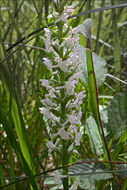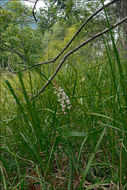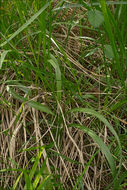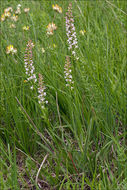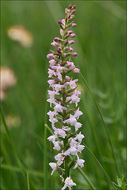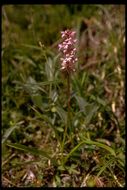-
Loista, Gotland, Sverige
-
Loista, Gotland, Sverige
-
Loista, Gotland, Sverige
-
Loista, Gotland, Sverige
-
Loista, Gotland, Sverige
-
Loista, Gotland, Sverige
-
Loista, Gotland, Sverige
-
Tofta Skjutfält, Gotland, Sverige
-
Gotland, Sverige
-
Slo.: diseci kukovicnik
-
Slo.: diseci kukovicnik
-
Slo.: diseci kukovicnik
-
Slo.: diseci kukovicnik
-

Slo.: diei kukovinik - Habitat: Riparian, calcareous, sandy ground, river deposits, flat terrain; in grass among river shore bushes (dominant Salix eleagnos, Picea abies), shallow ground water, half shade; partly protected from direct rain by bush canopies, elevation 570 m (1.850 feet), average precipitations ~ 3.000 mm/year, average temperature 7 - 9 deg C, alpine phytogeographical region. - Substratum: sandy river bank soil. - Comment: Gymnadenia odoratissima is a tender, medium sized orchid growing widespread in all parts of the Alps and other European mountains. In Slovenia it is more frequent in its northwest part, but it is nowhere a common plant. The plant is quite similar to smaller specimens of much more common Gymnadenia conopsea ssp. conopsea. Superficially seen, habitus, habitat, as well as shape and color of flowers of both species do not differ much. Literature usually states that strong, pleasant smell of Gymnadenia odoratissima (notice Latin species name) most easily distinguishes it from Gymnadenia conopsea ssp. conopsea. However, to my experience, many times also Gymnadenia conopsea smells quite distinctly and pleasantly. Also the size of the flowers, which is generally smaller with Gymnadenia odoratissima, is not always a reliable distinguishing trait. One can find also small plants (usually growing on nutrients poor ground) of Gymnadenia conopsea with very small flowers of the similar size as of Gymnadenia odoratissima. The most reliable distinguishing trait between both species seems to be the shape of spur. Flowers of Gymnadenia conopsea have very, very long, thin, distinctly downwards curved spur, which is always much longer than ovary, while Gymnadenia odoratissima has much shorter, thicker (relatively to flower size), more or less straight spur, which is of about the same length as ovary or slightly shorter. Seven plants were found along about a length of 15 m of river bank, one of them was completely white (see picture 14.). The color of Gymnadenia odoratissima varies significantly from very pale to intensive pink. White plants are rare. Protected according to 'Uredba o zavarovanih prostoiveih rastlinskih vrstah' Url. RS, t. 46/2004 (Regulation of protection of wild growing plants, Official Gazette of Republic Slovenia, No.:46/2004). Enlisted in the Slovene Red List of rare and endangered species, marked by 'V' representing a vulnerable species. Ref.: (1) M.A. Fischer, W. Adler, K. Oswald, Exkursionsflora sterreich Liechtenstein, Sdtirol, LO Landesmuseen, Linz, Austria (2005), p 1041. (2) A. Martini et all., Mala Flora Slovenije, Tehnina Zaloba Slovenije (2007) (in Slovene), p 772. (3) D. Aeschimann, K. Lauber, D.M. Moser, J.P. Theurillat, Flora Alpina, Vol. 2., Haupt (2004), p 1112. (4) B. Dolinar, Kukavievke v Sloveniji (Orchids in Slovenia), Pipinova Knjiga (2015), p 91. (5) H. Kretzschmar, Die Orchideen Deutschlands und angrenzender Lander, Quelle & Meyer (2008), p 152.
-
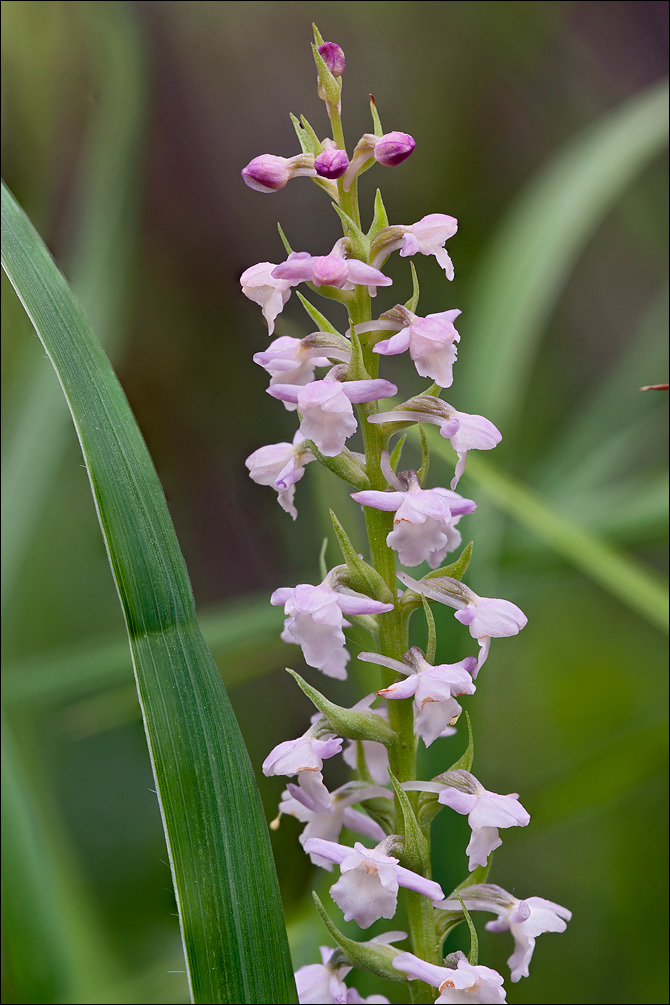
Slo.: diei kukovinik - Habitat: Riparian, calcareous, sandy ground, river deposits, flat terrain; in grass among river shore bushes (dominant Salix eleagnos, Picea abies), shallow ground water, half shade; partly protected from direct rain by bush canopies, elevation 570 m (1.850 feet), average precipitations ~ 3.000 mm/year, average temperature 7 - 9 deg C, alpine phytogeographical region. - Substratum: sandy river bank soil. - Comment: Gymnadenia odoratissima is a tender, medium sized orchid growing widespread in all parts of the Alps and other European mountains. In Slovenia it is more frequent in its northwest part, but it is nowhere a common plant. The plant is quite similar to smaller specimens of much more common Gymnadenia conopsea ssp. conopsea. Superficially seen, habitus, habitat, as well as shape and color of flowers of both species do not differ much. Literature usually states that strong, pleasant smell of Gymnadenia odoratissima (notice Latin species name) most easily distinguishes it from Gymnadenia conopsea ssp. conopsea. However, to my experience, many times also Gymnadenia conopsea smells quite distinctly and pleasantly. Also the size of the flowers, which is generally smaller with Gymnadenia odoratissima, is not always a reliable distinguishing trait. One can find also small plants (usually growing on nutrients poor ground) of Gymnadenia conopsea with very small flowers of the similar size as of Gymnadenia odoratissima. The most reliable distinguishing trait between both species seems to be the shape of spur. Flowers of Gymnadenia conopsea have very, very long, thin, distinctly downwards curved spur, which is always much longer than ovary, while Gymnadenia odoratissima has much shorter, thicker (relatively to flower size), more or less straight spur, which is of about the same length as ovary or slightly shorter. - Seven plants were found along about a length of 15 m of river bank, one of them was completely white (see picture 14.). The color of Gymnadenia odoratissima varies significantly from very pale to intensive pink. White plants are rare. - Protected according to 'Uredba o zavarovanih prostoiveih rastlinskih vrstah' Url. RS, t. 46/2004 (Regulation of protection of wild growing plants, Official Gazette of Republic Slovenia, No.:46/2004). Enlisted in the Slovene Red List of rare and endangered species, marked by 'V' representing a vulnerable species. - Ref.: (1) M.A. Fischer, W. Adler, K. Oswald, Exkursionsflora sterreich Liechtenstein, Sdtirol, LO Landesmuseen, Linz, Austria (2005), p 1041. (2) A. Martini et all., Mala Flora Slovenije, Tehnina Zaloba Slovenije (2007) (in Slovene), p 772. (3) D. Aeschimann, K. Lauber, D.M. Moser, J.P. Theurillat, Flora Alpina, Vol. 2., Haupt (2004), p 1112. (4) B. Dolinar, Kukavievke v Sloveniji (Orchids in Slovenia), Pipinova Knjiga (2015), p 91. (5) H. Kretzschmar, Die Orchideen Deutschlands und angrenzender Lander, Quelle & Meyer (2008), p 152.
-
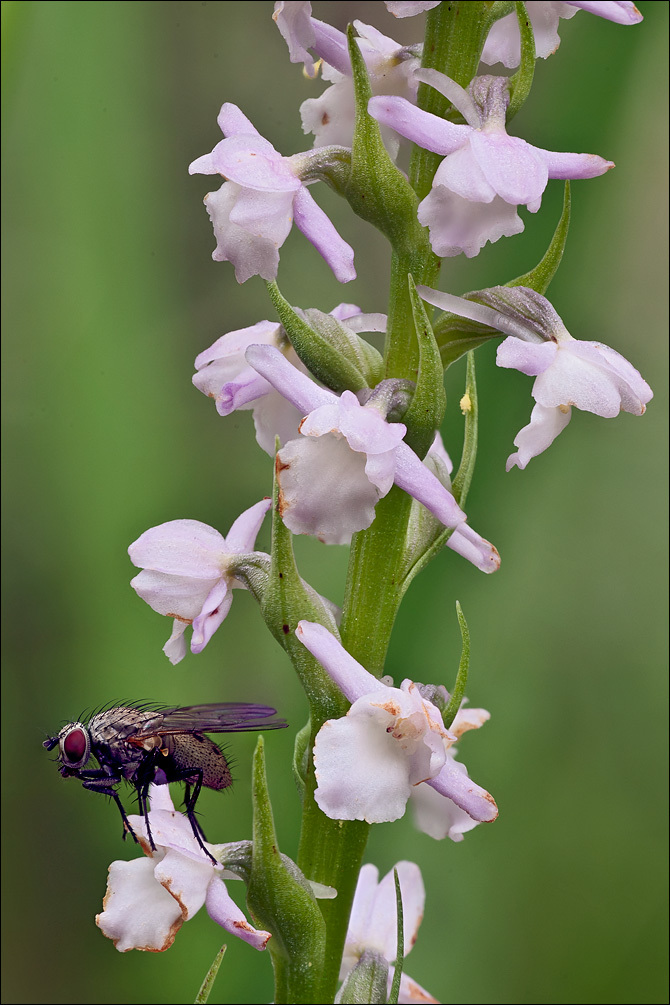
Slo.: diei kukovinik - syn.: Orchis odoratissima L. - Habitat: Riparian, calcareous, sandy ground, river deposits, flat terrain; in grass among river shore bushes (dominant Salix eleagnos, Picea abies), shallow ground water, half shade; partly protected from direct rain by bush canopies, elevation 570 m (1.850 feet), average precipitations ~ 3.000 mm/year, average temperature 7 - 9 deg C, alpine phytogeographical region. - Substratum: sandy river bank soil. - Comment: Gymnadenia odoratissima is a tender, medium sized orchid growing widespread in all parts of the Alps and other European mountains. In Slovenia it is more frequent in its northwest part, but it is nowhere a common plant. The plant is quite similar to smaller specimens of much more common Gymnadenia conopsea ssp. conopsea. Superficially seen, habitus, habitat, as well as shape and color of flowers of both species do not differ much. Literature usually states that strong, pleasant smell of Gymnadenia odoratissima (notice Latin species name) most easily distinguishes it from Gymnadenia conopsea ssp. conopsea. However, to my experience, many times also Gymnadenia conopsea smells quite distinctly and pleasantly. Also the size of the flowers, which is generally smaller with Gymnadenia odoratissima, is not always a reliable distinguishing trait. One can find also small plants (usually growing on nutrients poor ground) of Gymnadenia conopsea with very small flowers of the similar size as of Gymnadenia odoratissima. The most reliable distinguishing trait between both species seems to be the shape of spur. Flowers of Gymnadenia conopsea have very, very long, thin, distinctly downwards curved spur, which is always much longer than ovary, while Gymnadenia odoratissima has much shorter, thicker (relatively to flower size), more or less straight spur, which is of about the same length as ovary or slightly shorter. - Seven plants were found along about a length of 15 m of river bank, one of them was completely white (see picture 14.). The color of Gymnadenia odoratissima varies significantly from very pale to intensive pink. White plants are rare. - Protected according to 'Uredba o zavarovanih prostoiveih rastlinskih vrstah' Url. RS, t. 46/2004 (Regulation of protection of wild growing plants, Official Gazette of Republic Slovenia, No.:46/2004). Enlisted in the Slovene Red List of rare and endangered species, marked by 'V' representing a vulnerable species. - Ref.: (1) M.A. Fischer, W. Adler, K. Oswald, Exkursionsflora sterreich Liechtenstein, Sdtirol, LO Landesmuseen, Linz, Austria (2005), p 1041. (2) A. Martini et all., Mala Flora Slovenije, Tehnina Zaloba Slovenije (2007) (in Slovene), p 772. (3) D. Aeschimann, K. Lauber, D.M. Moser, J.P. Theurillat, Flora Alpina, Vol. 2., Haupt (2004), p 1112. (4) B. Dolinar, Kukavievke v Sloveniji (Orchids in Slovenia), Pipinova Knjiga (2015), p 91. (5) H. Kretzschmar, Die Orchideen Deutschlands und angrenzender Lander, Quelle & Meyer (2008), p 152.
-
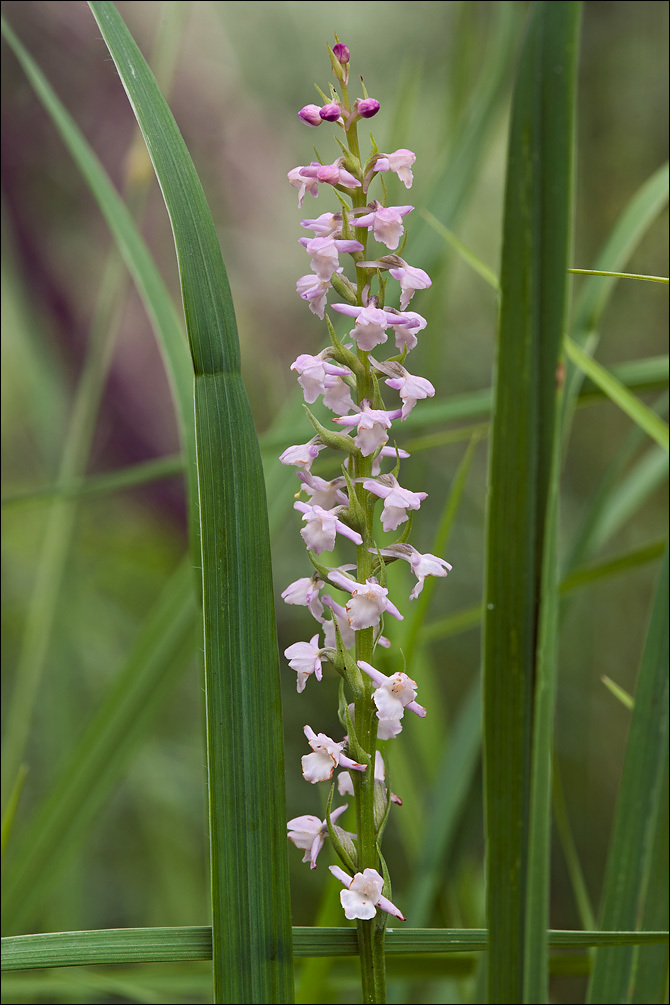
Slo.: diei kukovinik - syn.: Orchis odoratissima L. - Habitat: Riparian, calcareous, sandy ground, river deposits, flat terrain; in grass among river shore bushes (dominant Salix eleagnos, Picea abies), shallow ground water, half shade; partly protected from direct rain by bush canopies, elevation 570 m (1.850 feet), average precipitations ~ 3.000 mm/year, average temperature 7 - 9 deg C, alpine phytogeographical region. - Substratum: sandy river bank soil. - Comment: Gymnadenia odoratissima is a tender, medium sized orchid growing widespread in all parts of the Alps and other European mountains. In Slovenia it is more frequent in its northwest part, but it is nowhere a common plant. The plant is quite similar to smaller specimens of much more common Gymnadenia conopsea ssp. conopsea. Superficially seen, habitus, habitat, as well as shape and color of flowers of both species do not differ much. Literature usually states that strong, pleasant smell of Gymnadenia odoratissima (notice Latin species name) most easily distinguishes it from Gymnadenia conopsea ssp. conopsea. However, to my experience, many times also Gymnadenia conopsea smells quite distinctly and pleasantly. Also the size of the flowers, which is generally smaller with Gymnadenia odoratissima, is not always a reliable distinguishing trait. One can find also small plants (usually growing on nutrients poor ground) of Gymnadenia conopsea with very small flowers of the similar size as of Gymnadenia odoratissima. The most reliable distinguishing trait between both species seems to be the shape of spur. Flowers of Gymnadenia conopsea have very, very long, thin, distinctly downwards curved spur, which is always much longer than ovary, while Gymnadenia odoratissima has much shorter, thicker (relatively to flower size), more or less straight spur, which is of about the same length as ovary or slightly shorter. - Seven plants were found along about a length of 15 m of river bank, one of them was completely white (see picture 14.). The color of Gymnadenia odoratissima varies significantly from very pale to intensive pink. White plants are rare. - Protected according to 'Uredba o zavarovanih prostoiveih rastlinskih vrstah' Url. RS, t. 46/2004 (Regulation of protection of wild growing plants, Official Gazette of Republic Slovenia, No.:46/2004). Enlisted in the Slovene Red List of rare and endangered species, marked by 'V' representing a vulnerable species. - Ref.: (1) M.A. Fischer, W. Adler, K. Oswald, Exkursionsflora sterreich Liechtenstein, Sdtirol, LO Landesmuseen, Linz, Austria (2005), p 1041. (2) A. Martini et all., Mala Flora Slovenije, Tehnina Zaloba Slovenije (2007) (in Slovene), p 772. (3) D. Aeschimann, K. Lauber, D.M. Moser, J.P. Theurillat, Flora Alpina, Vol. 2., Haupt (2004), p 1112. (4) B. Dolinar, Kukavievke v Sloveniji (Orchids in Slovenia), Pipinova Knjiga (2015), p 91. (5) H. Kretzschmar, Die Orchideen Deutschlands und angrenzender Lander, Quelle & Meyer (2008), p 152.
-
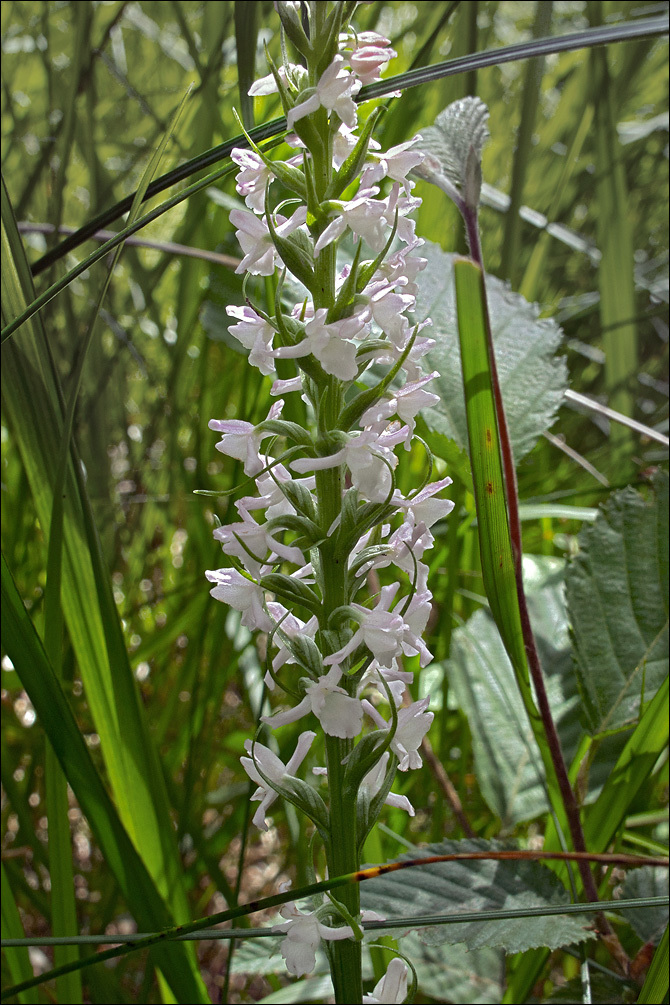
Slo.: diei kukovinik - syn.: Orchis odoratissima L. - Habitat: Riparian, calcareous, sandy ground, river deposits, flat terrain; in grass among river shore bushes (dominant Salix eleagnos, Picea abies), shallow ground water, half shade; partly protected from direct rain by bush canopies, elevation 570 m (1.850 feet), average precipitations ~ 3.000 mm/year, average temperature 7 - 9 deg C, alpine phytogeographical region. - Substratum: sandy river bank soil. - Comment: Gymnadenia odoratissima is a tender, medium sized orchid growing widespread in all parts of the Alps and other European mountains. In Slovenia it is more frequent in its northwest part, but it is nowhere a common plant. The plant is quite similar to smaller specimens of much more common Gymnadenia conopsea ssp. conopsea. Superficially seen, habitus, habitat, as well as shape and color of flowers of both species do not differ much. Literature usually states that strong, pleasant smell of Gymnadenia odoratissima (notice Latin species name) most easily distinguishes it from Gymnadenia conopsea ssp. conopsea. However, to my experience, many times also Gymnadenia conopsea smells quite distinctly and pleasantly. Also the size of the flowers, which is generally smaller with Gymnadenia odoratissima, is not always a reliable distinguishing trait. One can find also small plants (usually growing on nutrients poor ground) of Gymnadenia conopsea with very small flowers of the similar size as of Gymnadenia odoratissima. The most reliable distinguishing trait between both species seems to be the shape of spur. Flowers of Gymnadenia conopsea have very, very long, thin, distinctly downwards curved spur, which is always much longer than ovary, while Gymnadenia odoratissima has much shorter, thicker (relatively to flower size), more or less straight spur, which is of about the same length as ovary or slightly shorter. - Seven plants were found along about a length of 15 m of river bank, one of them was completely white (see picture 14.). The color of Gymnadenia odoratissima varies significantly from very pale to intensive pink. White plants are rare. - Protected according to 'Uredba o zavarovanih prostoiveih rastlinskih vrstah' Url. RS, t. 46/2004 (Regulation of protection of wild growing plants, Official Gazette of Republic Slovenia, No.:46/2004). Enlisted in the Slovene Red List of rare and endangered species, marked by 'V' representing a vulnerable species. - Ref.: (1) M.A. Fischer, W. Adler, K. Oswald, Exkursionsflora sterreich Liechtenstein, Sdtirol, LO Landesmuseen, Linz, Austria (2005), p 1041. (2) A. Martini et all., Mala Flora Slovenije, Tehnina Zaloba Slovenije (2007) (in Slovene), p 772. (3) D. Aeschimann, K. Lauber, D.M. Moser, J.P. Theurillat, Flora Alpina, Vol. 2., Haupt (2004), p 1112. (4) B. Dolinar, Kukavievke v Sloveniji (Orchids in Slovenia), Pipinova Knjiga (2015), p 91. (5) H. Kretzschmar, Die Orchideen Deutschlands und angrenzender Lander, Quelle & Meyer (2008), p 152.
-
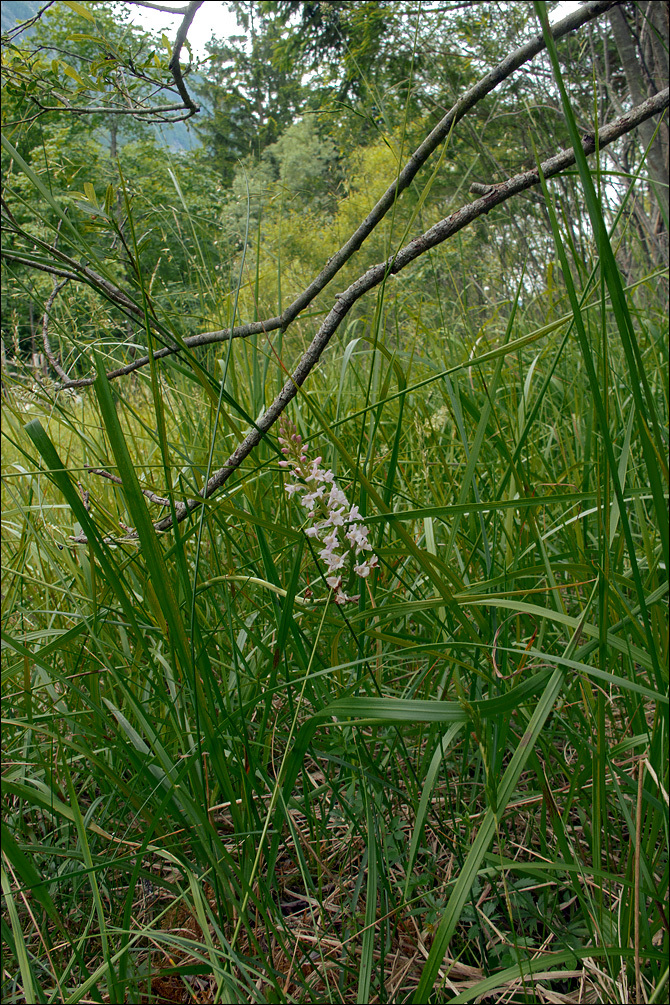
Slo.: diei kukovinik - syn.: Orchis odoratissima L. - Habitat: Riparian, calcareous, sandy ground, river deposits, flat terrain; in grass among river shore bushes (dominant Salix eleagnos, Picea abies), shallow ground water, half shade; partly protected from direct rain by bush canopies, elevation 570 m (1.850 feet), average precipitations ~ 3.000 mm/year, average temperature 7 - 9 deg C, alpine phytogeographical region. - Substratum: sandy river bank soil. - Comment: Gymnadenia odoratissima is a tender, medium sized orchid growing widespread in all parts of the Alps and other European mountains. In Slovenia it is more frequent in its northwest part, but it is nowhere a common plant. The plant is quite similar to smaller specimens of much more common Gymnadenia conopsea ssp. conopsea. Superficially seen, habitus, habitat, as well as shape and color of flowers of both species do not differ much. Literature usually states that strong, pleasant smell of Gymnadenia odoratissima (notice Latin species name) most easily distinguishes it from Gymnadenia conopsea ssp. conopsea. However, to my experience, many times also Gymnadenia conopsea smells quite distinctly and pleasantly. Also the size of the flowers, which is generally smaller with Gymnadenia odoratissima, is not always a reliable distinguishing trait. One can find also small plants (usually growing on nutrients poor ground) of Gymnadenia conopsea with very small flowers of the similar size as of Gymnadenia odoratissima. The most reliable distinguishing trait between both species seems to be the shape of spur. Flowers of Gymnadenia conopsea have very, very long, thin, distinctly downwards curved spur, which is always much longer than ovary, while Gymnadenia odoratissima has much shorter, thicker (relatively to flower size), more or less straight spur, which is of about the same length as ovary or slightly shorter. - Seven plants were found along about a length of 15 m of river bank, one of them was completely white (see picture 14.). The color of Gymnadenia odoratissima varies significantly from very pale to intensive pink. White plants are rare. - Protected according to 'Uredba o zavarovanih prostoiveih rastlinskih vrstah' Url. RS, t. 46/2004 (Regulation of protection of wild growing plants, Official Gazette of Republic Slovenia, No.:46/2004). Enlisted in the Slovene Red List of rare and endangered species, marked by 'V' representing a vulnerable species. - Ref.: (1) M.A. Fischer, W. Adler, K. Oswald, Exkursionsflora sterreich Liechtenstein, Sdtirol, LO Landesmuseen, Linz, Austria (2005), p 1041. (2) A. Martini et all., Mala Flora Slovenije, Tehnina Zaloba Slovenije (2007) (in Slovene), p 772. (3) D. Aeschimann, K. Lauber, D.M. Moser, J.P. Theurillat, Flora Alpina, Vol. 2., Haupt (2004), p 1112. (4) B. Dolinar, Kukavievke v Sloveniji (Orchids in Slovenia), Pipinova Knjiga (2015), p 91. (5) H. Kretzschmar, Die Orchideen Deutschlands und angrenzender Lander, Quelle & Meyer (2008), p 152.
-

Slo.: diei kukovinik - syn.: Orchis odoratissima L. - Habitat: Riparian, calcareous, sandy ground, river deposits, flat terrain; in grass among river shore bushes (dominant Salix eleagnos, Picea abies), shallow ground water, half shade; partly protected from direct rain by bush canopies, elevation 570 m (1.850 feet), average precipitations ~ 3.000 mm/year, average temperature 7 - 9 deg C, alpine phytogeographical region. - Substratum: sandy river bank soil. - Comment: Gymnadenia odoratissima is a tender, medium sized orchid growing widespread in all parts of the Alps and other European mountains. In Slovenia it is more frequent in its northwest part, but it is nowhere a common plant. The plant is quite similar to smaller specimens of much more common Gymnadenia conopsea ssp. conopsea. Superficially seen, habitus, habitat, as well as shape and color of flowers of both species do not differ much. Literature usually states that strong, pleasant smell of Gymnadenia odoratissima (notice Latin species name) most easily distinguishes it from Gymnadenia conopsea ssp. conopsea. However, to my experience, many times also Gymnadenia conopsea smells quite distinctly and pleasantly. Also the size of the flowers, which is generally smaller with Gymnadenia odoratissima, is not always a reliable distinguishing trait. One can find also small plants (usually growing on nutrients poor ground) of Gymnadenia conopsea with very small flowers of the similar size as of Gymnadenia odoratissima. The most reliable distinguishing trait between both species seems to be the shape of spur. Flowers of Gymnadenia conopsea have very, very long, thin, distinctly downwards curved spur, which is always much longer than ovary, while Gymnadenia odoratissima has much shorter, thicker (relatively to flower size), more or less straight spur, which is of about the same length as ovary or slightly shorter. - Seven plants were found along about a length of 15 m of river bank, one of them was completely white (see picture 14.). The color of Gymnadenia odoratissima varies significantly from very pale to intensive pink. White plants are rare. - Protected according to 'Uredba o zavarovanih prostoiveih rastlinskih vrstah' Url. RS, t. 46/2004 (Regulation of protection of wild growing plants, Official Gazette of Republic Slovenia, No.:46/2004). Enlisted in the Slovene Red List of rare and endangered species, marked by 'V' representing a vulnerable species. - Ref.: (1) M.A. Fischer, W. Adler, K. Oswald, Exkursionsflora sterreich Liechtenstein, Sdtirol, LO Landesmuseen, Linz, Austria (2005), p 1041. (2) A. Martini et all., Mala Flora Slovenije, Tehnina Zaloba Slovenije (2007) (in Slovene), p 772. (3) D. Aeschimann, K. Lauber, D.M. Moser, J.P. Theurillat, Flora Alpina, Vol. 2., Haupt (2004), p 1112. (4) B. Dolinar, Kukavievke v Sloveniji (Orchids in Slovenia), Pipinova Knjiga (2015), p 91. (5) H. Kretzschmar, Die Orchideen Deutschlands und angrenzender Lander, Quelle & Meyer (2008), p 152.
-
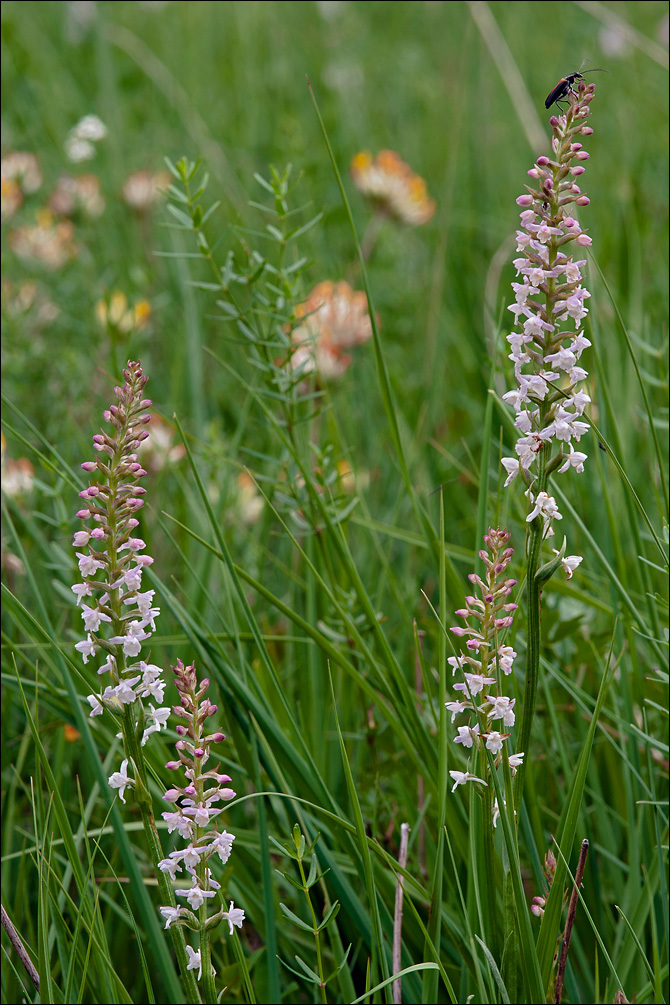
Slo.: diei kukovinik - syn.: Orchis odoratissima L. - Habitat: Riparian unmaintained grassland, calcareous ground, old river deposits, flat terrain; shallow ground water level, full sun; exposed to direct rain, elevation 570 m (1.850 feet), average precipitations ~ 3.000 mm/year, average temperature 7 - 9 deg C, alpine phytogeographical region. - Substratum: soil. - Comment: Gymnadenia odoratissima is a tender, medium sized orchid growing widespread in all parts of the Alps and other European mountains. In Slovenia it is more frequent in its northwest part, but it is nowhere a common plant. - The plant is quite similar to smaller specimens of much more common Gymnadenia conopsea ssp. conopsea. Superficially seen, habitus, habitat, as well as shape and color of flowers of both species do not differ much. Literature usually states that strong, pleasant smell of Gymnadenia odoratissima (notice Latin species name) most easily distinguishes it from Gymnadenia conopsea ssp. conopsea. However, to my experience, many times also Gymnadenia conopsea smells quite distinctly and pleasantly. Also the size of the flowers, which is generally smaller with Gymnadenia odoratissima, is not always a reliable distinguishing trait. One can find also small plants (usually growing on nutrients poor ground) of Gymnadenia conopsea with very small flowers of the similar size as of Gymnadenia odoratissima. The most reliable distinguishing trait between both species seems to be the shape of spur. Flowers of Gymnadenia conopsea have very, very long, thin, distinctly downwards curved spur, which is always much longer than ovary, while Gymnadenia odoratissima has much shorter, thicker (relatively to flower size), more or less straight spur, which is of about the same length as ovary or slightly shorter. - More than ten plants were found on this piece of grassland. - Protected according to 'Uredba o zavarovanih prostoiveih rastlinskih vrstah' Url. RS, t. 46/2004 (Regulation of protection of wild growing plants, Official Gazette of Republic Slovenia, No.:46/2004). Enlisted in the Slovene Red List of rare and endangered species, marked by 'V' representing a vulnerable species. - Ref.: (1) M.A. Fischer, W. Adler, K. Oswald, Exkursionsflora sterreich Liechtenstein, Sdtirol, LO Landesmuseen, Linz, Austria (2005), p 1041. (2) A. Martini et all., Mala Flora Slovenije, Tehnina Zaloba Slovenije (2007) (in Slovene), p 772. (3) D. Aeschimann, K. Lauber, D.M. Moser, J.P. Theurillat, Flora Alpina, Vol. 2., Haupt (2004), p 1112. (4) B. Dolinar, Kukavievke v Sloveniji (Orchids in Slovenia), Pipinova Knjiga (2015), p 91. (5) H. Kretzschmar, Die Orchideen Deutschlands und angrenzender Lander, Quelle & Meyer (2008), p 152.
-
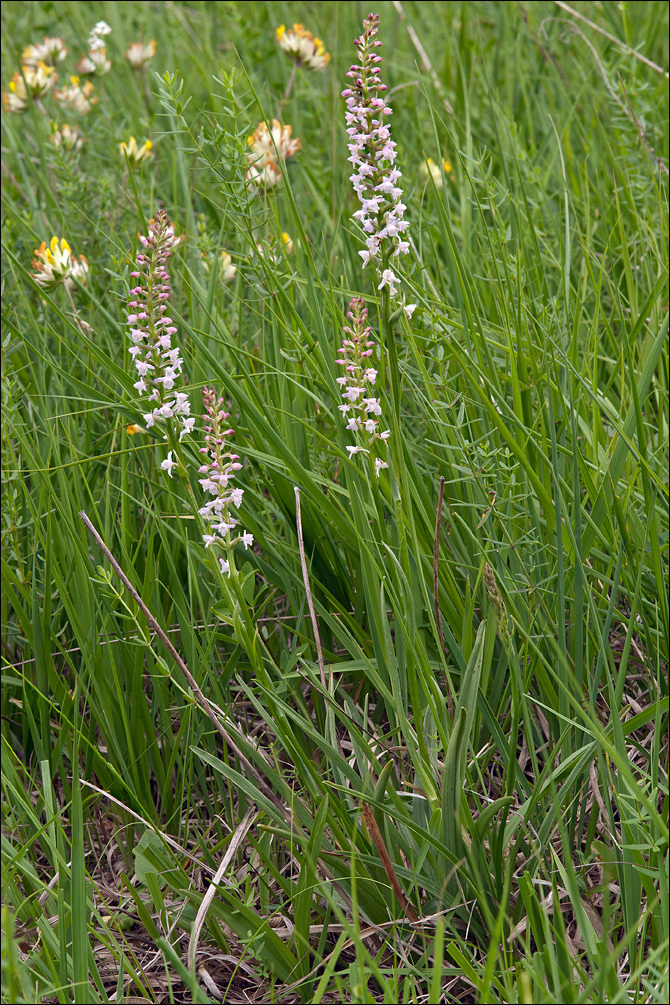
Slo.: diei kukovinik - syn.: Orchis odoratissima L. - Habitat: Riparian unmaintained grassland, calcareous ground, old river deposits, flat terrain; shallow ground water level, full sun; exposed to direct rain, elevation 570 m (1.850 feet), average precipitations ~ 3.000 mm/year, average temperature 7 - 9 deg C, alpine phytogeographical region. - Substratum: soil. - Comment: Gymnadenia odoratissima is a tender, medium sized orchid growing widespread in all parts of the Alps and other European mountains. In Slovenia it is more frequent in its northwest part, but it is nowhere a common plant. - The plant is quite similar to smaller specimens of much more common Gymnadenia conopsea ssp. conopsea. Superficially seen, habitus, habitat, as well as shape and color of flowers of both species do not differ much. Literature usually states that strong, pleasant smell of Gymnadenia odoratissima (notice Latin species name) most easily distinguishes it from Gymnadenia conopsea ssp. conopsea. However, to my experience, many times also Gymnadenia conopsea smells quite distinctly and pleasantly. Also the size of the flowers, which is generally smaller with Gymnadenia odoratissima, is not always a reliable distinguishing trait. One can find also small plants (usually growing on nutrients poor ground) of Gymnadenia conopsea with very small flowers of the similar size as of Gymnadenia odoratissima. The most reliable distinguishing trait between both species seems to be the shape of spur. Flowers of Gymnadenia conopsea have very, very long, thin, distinctly downwards curved spur, which is always much longer than ovary, while Gymnadenia odoratissima has much shorter, thicker (relatively to flower size), more or less straight spur, which is of about the same length as ovary or slightly shorter. - More than ten plants were found on this piece of grassland. - Protected according to 'Uredba o zavarovanih prostoiveih rastlinskih vrstah' Url. RS, t. 46/2004 (Regulation of protection of wild growing plants, Official Gazette of Republic Slovenia, No.:46/2004). Enlisted in the Slovene Red List of rare and endangered species, marked by 'V' representing a vulnerable species. - Ref.: (1) M.A. Fischer, W. Adler, K. Oswald, Exkursionsflora sterreich Liechtenstein, Sdtirol, LO Landesmuseen, Linz, Austria (2005), p 1041. (2) A. Martini et all., Mala Flora Slovenije, Tehnina Zaloba Slovenije (2007) (in Slovene), p 772. (3) D. Aeschimann, K. Lauber, D.M. Moser, J.P. Theurillat, Flora Alpina, Vol. 2., Haupt (2004), p 1112. (4) B. Dolinar, Kukavievke v Sloveniji (Orchids in Slovenia), Pipinova Knjiga (2015), p 91. (5) H. Kretzschmar, Die Orchideen Deutschlands und angrenzender Lander, Quelle & Meyer (2008), p 152.
-

Slo.: diei kukovinik - syn.: Orchis odoratissima L. - Habitat: Riparian unmaintained grassland, calcareous ground, old river deposits, flat terrain; shallow ground water level, full sun; exposed to direct rain, elevation 570 m (1.850 feet), average precipitations ~ 3.000 mm/year, average temperature 7 - 9 deg C, alpine phytogeographical region. - Substratum: soil. - Comment: Gymnadenia odoratissima is a tender, medium sized orchid growing widespread in all parts of the Alps and other European mountains. In Slovenia it is more frequent in its northwest part, but it is nowhere a common plant. - The plant is quite similar to smaller specimens of much more common Gymnadenia conopsea ssp. conopsea. Superficially seen, habitus, habitat, as well as shape and color of flowers of both species do not differ much. Literature usually states that strong, pleasant smell of Gymnadenia odoratissima (notice Latin species name) most easily distinguishes it from Gymnadenia conopsea ssp. conopsea. However, to my experience, many times also Gymnadenia conopsea smells quite distinctly and pleasantly. Also the size of the flowers, which is generally smaller with Gymnadenia odoratissima, is not always a reliable distinguishing trait. One can find also small plants (usually growing on nutrients poor ground) of Gymnadenia conopsea with very small flowers of the similar size as of Gymnadenia odoratissima. The most reliable distinguishing trait between both species seems to be the shape of spur. Flowers of Gymnadenia conopsea have very, very long, thin, distinctly downwards curved spur, which is always much longer than ovary, while Gymnadenia odoratissima has much shorter, thicker (relatively to flower size), more or less straight spur, which is of about the same length as ovary or slightly shorter. - More than ten plants were found on this piece of grassland. - Protected according to 'Uredba o zavarovanih prostoiveih rastlinskih vrstah' Url. RS, t. 46/2004 (Regulation of protection of wild growing plants, Official Gazette of Republic Slovenia, No.:46/2004). Enlisted in the Slovene Red List of rare and endangered species, marked by 'V' representing a vulnerable species. - Ref.: (1) M.A. Fischer, W. Adler, K. Oswald, Exkursionsflora sterreich Liechtenstein, Sdtirol, LO Landesmuseen, Linz, Austria (2005), p 1041. (2) A. Martini et all., Mala Flora Slovenije, Tehnina Zaloba Slovenije (2007) (in Slovene), p 772. (3) D. Aeschimann, K. Lauber, D.M. Moser, J.P. Theurillat, Flora Alpina, Vol. 2., Haupt (2004), p 1112. (4) B. Dolinar, Kukavievke v Sloveniji (Orchids in Slovenia), Pipinova Knjiga (2015), p 91. (5) H. Kretzschmar, Die Orchideen Deutschlands und angrenzender Lander, Quelle & Meyer (2008), p 152.
-
1999 California Academy of Sciences
CalPhotos
nonnative

